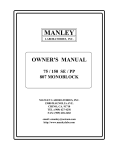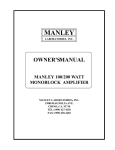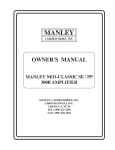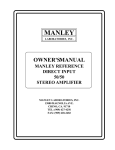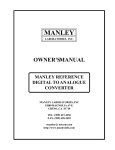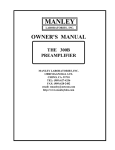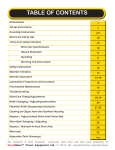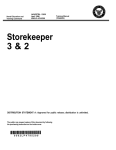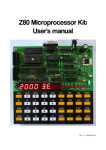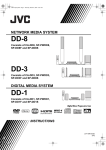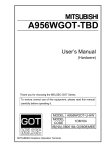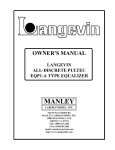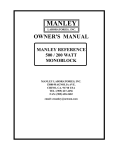Download Manley 120 Watt Monoblock Amplifier Owner`s manual
Transcript
MANLEY LABORATORIES, INC. OWNER'S MANUAL MANLEY SE / PP 300B "RETRO" AMPLIFIER MANLEY LABORATORIES, INC. 13880 MAGNOLIA AVE. CHINO, CA. 91710 TEL: (909) 627-4256 FAX: (909) 628-2482 CONTENTS SECTION PAGE INTRODUCTION 3 MAINS CONNECTIONS 4 CONNECTING YOUR AMPLIFIER 5 DIAGRAM 2 6 TOP PANEL BIAS PROCEDURES 7 OPERATIONAL NOTES 8 SPECIFICATIONS 9 WARRANTY 10 WARRANTY REGISTRATION 11 INTRODUCTION THANK YOU!... for choosing the Manley SE / PP 300B TRIODE Monoblock Amplifiers. Designed by David Manley, the Manley SE / PP 300B TRIODE Amplifiers use only the best available components, with the shortest and cleanest signal path possible. These amps have the unique ability to switch from Single ended to Push-Pull topologies and the ability to adjust the amount of negative feedback in 1 dB steps. This amp is designed to provide our customers with a versatile little amplifier that can do it all. Let us start out by stating our opinions about amplifier topologies. Historically, we have been manufacturing very highly regarded tube amplifiers since before tubes were considered the best option for hi-fi music lovers. We have manufactured a very wide range of amplifiers with power ranging from 15 watts to 800 watts and with a corresponding variety of tubes. This is not our first amp to feature 300Bs nor our first single ended triode amp. We build a $15,000 70+ watt single ended amp on a custom basis. In our experience, the more power an amplifier is capable of - the better it will be at providing acceptable low frequency quality. It is not easy to produce a very powerful amp with highs of the same quality as the lows. To do that we had to start manufacturing our own transformers. This is the major development that allowed us to produce an amplifier that could switch from single-ended to push-pull. We had to design and build a very unusual transformer first. When several other manufacturers started selling single-ended amps with 5 to 9 watts of power, we understood subjectively and objectively the good part of the story - the superb mid range - the delicate transient detail - the inherent simplicity. The bad news was that there were almost no speakers efficient enough to be a dynamic viable system. The worse news was that either these single-ended amps cost more than the condo or they had specs that could only be a joke. As the triode fans increased, more efficient speakers became available and several fanatics began to dismiss push-pull as a bad thing to be avoided at all costs. We objected to such blanket generalities and stressed that the push-pull done right with truly balanced transformers, quality parts throughout and a well designed circuit has proven to be a superb technique. We also like single ended amps, but few and far between, mostly because we prefer a flat frequency response and low distortion. We knew could do it better. We set out to design an amplifier that would appeal to us and to you and to the critics. It would be single-ended with more power than most for fans of that topology. It would be switchable to push-pull for fans of that school and for those who want it both ways - to compare for themselves, and to use each mode depending on the music. We decided to further extend our own feature of variable negative feedback to a greater range - from none to 10 dB. Some prefer zero negative feedback and some prefer more. The advantage of a little negative feedback is better specifications in general. Williamson, in 1947, not only described the advantages but described the loss of some transient information with greater than 20 dBof feedback. We typically use 3 to 6 dB in other amps. Even with zero negative feedback, this amp is cleaner and flatter than any single-ended amp we know of. One interesting aspect of negative feedback is it gives a higher damping factor. Conventional wisdom would have us think that the higher the damping factor - the better. Our experience is that the optimum damping factor is not infinity and that it depends on the speaker, the room, and the taste of the listener. In other words, the optimum is variability, and this we provide. This amp satisfies us as long time amplifier builders, amazes the critics in several well known magazines and is bound to satisfy the you with the ability to fit into your system and your expectations. We offer two versions of this amplifier. One version uses a 5V4 tube rectifier and 6SL7 & 6SN7 input stage. The chassis is more rectangular. This retro-look has appeal in the far-east and this version is only built for that part of the world. We also build a more conventional looking amp for our American and European customers. These use a solid state rectifier and12AT7 / 7044 input stage similar to our other amps. Otherwise the amps are brothers both in circuit and performance. Both amplifiers have a highly polished look thanks to the gold and chrome finishes. These new metal technologies were not available a few years ago. Built to last a lifetime. Designed to look elegant. Engineered by David Manley who happens to love music enough to be his lifes career. READ THIS PAGE BEFORE YOU SET UP THE AMPS, PLEASE IMPORTANT Never operate this amp without a speaker or load connected. Never drive this amp into a short circuit. Most solid state amps can be operated without a load or speaker and some can drive a short circuit because of protection circuitry. These are different - Like most tube amps the output power is less affected by changing the load impedance within the range of 4 to 16 ohms, however extremes like a short or open circuit are to be avoided. The result could be damage to transformers, tubes. The warranty does not cover this damage if it occurs. INSERTING TUBES We ship these amplifiers with the 300B tubes boxed separately because they are fragile and expensive. You will have to insert these before turning the amplifier on. Carefully upack the 300B tubes from their box and ensure they have not been physically damaged. We have labelled each tube and its corresponding socket. Notice that there are two thick pins and two thinner pins on the base of the 300B. The two thick pins MUST be alligned and oriented to go into the two larger holes in the socket. It is possible to plug this tube in the wrong way - so pay careful attention to the pin alignment on these tubes. Now plug the right tube into the right socket the right way. This is easy but important. GENERAL NOTES Pay special attention to pin alignment ! The 2 small pins must go into the 2 small socket holes. The tubes must be inserted carefully and speakers connected before turning the amp on. LOCATION & VENTILATION The Manley SE/PP 300B Monoblock Amplifiers must be installed in a stable location with ample ventilation. Allow a minimum of 2 inches of clearance on the top and sides of the amplifiers, such that a constant flow of air can flow. Do not place amplifiers directly on high pile carpet or any other surface that will block the ventilation vents underneath the amplifiers. If you have small children or pets, you should consider placing the amplifiers out of reach to prevent damage to the amplifier or damage to your small children or pets by the amplifier as the tubes WATER & MOISTURE As with any electrical equipment, these amplifiers should not be used near water or moisture. If liquid enters the amplifier, it must be immediately returned to your dealer for servicing. SERVICING The user should not attempt to service the amplifier beyond that described in the owner's manual. Refer all servicing other than biasing and tube replacement to Manley Laboratories SPECIAL NOTES Before turning the amps on - Connect your preamp to the amp inputs then turn the preamp on. Tubes may become loose during transit. Straighten and press down each tube before plugging the amplifier into the mains socket. Furthermore, do not touch the tubes after the amplifier has been switched on, as the tubes become very hot during operation and should only be handled after the power has been turned off and the tubes have cooled. HUM As with most monoblock amps with the 3 pin IEC power connectors, you may need one or two "3 pin to 2 pin" power adapters or "cheaters". This will stop ground loop related hum. Usually only one amp will need this. WARNING! TO PREVENT THE RISK OF ELECTRIC SHOCK DO NOT OPEN THE CABINET. REFER SERVICING TO QUALIFIED PERSONEL. MAINS CONNECTIONS Your amplifier has been factory set to the correct mains voltage for your country. The voltage setting is marked on the serial badge, located on the rear panel. Check that this complies with your local supply. Export units for certain markets have a moulded mains plug fitted to comply with local requirements. If your unit does not have a plug fitted the coloured wires should be connected to the appropriate plug terminals in accordance with the following code. GREEN/YELLOW BLUE BROWN EARTH NEUTRAL LIVE terminal terminal terminal As the colours of the wires in the mains lead may not correspond with the coloured marking identifying the terminals in your plug proceed as follows; The wire which is coloured GREEN/YELLOW must be connected to the terminal in the plug which is marked by the letter E or by the safety earth symbol or coloured GREEN or GREEN and YELLOW. The wire which is coloured BLUE must be connected to the terminal in the plug which is marked by the letter N or coloured BLACK. The wire which is coloured BROWN must be connected to the terminal in the plug which is marked by the letter L or coloured RED. DO NOT CONNECT/SWITCH ON THE MAINS SUPPLY UNTIL ALL OTHER CONNECTIONS HAVE BEEN MADE. CONNECTING YOUR AMPLIFIER Setting up your amplifiers is rather easy. 1. Connect all source components (turntable, CD, Tuner, Tape DAT, etc.) to your preamplifier. 2. Connect the interconnects from the output of the preamplifier or switching center to the RCA input on the top rear of the amplifiers. 3. Connect the hot or "+" speaker cable to the red binding post and the common or "-" speaker cable to the black binding post (See diagarm 2). Ensure that the other end of the cable is connected correctly to the speaker. Tighten the binding posts by hand. If you use a nut-driver (3/8") do not over-tighten the posts or you may break the connections inside the amplifier. 4. Ensure that the "mains" switch on the front panel is in the "off" or "0" position. If the 300Bs are not inserted - do it now - the instructions are on page 4. 5. Turn on Preamplifier and any source components you plan to use. 6. Plug Amplifiers into wall outlets. 7. Set both amps up at the same settings. A good place to start is both amps set to S / E 18 WATTS and 3 dB of FEEDBACK. 8. Switch the square mains power switch to the ON or "1" position and allow the amplifier a minute or so to 'warm up'. The glowing panel and glowing tubes will indicate that the amplifier is on. 9. Turn up the volume on the preamp and enjoy. If something is "humming" don't panic. All you need to do is use a "3 pin to 2 pin AC adapter" or "cheater". If you don't have one they are available at most hardware stores for about a dollar. Usually one amp will need it but sometimes both. This is because a ground loop exists in the system. Too many grounds - You should only have one. 10. Now, while music is playing, try switching to PUSH / PULL. The difference may or may not be subtle. Choose the mode you like best with this music. Turn the FEEDBACK switch to 10. The volume has become quieter so compensate for the difference at the preamp. Listen a bit until you are used to this, then turn down the volume and turn back the FEEDBACK to 0. Adjust the preamp for the same volume as the previous test. Now, you should have a reasonable opinion of the effects of the FEEDBACK. You can turn this control step by step to the position that best matches your speakers and tastes. We suggest also experimenting with speaker placement now that the "system" has changed. Another very important area for experimentation is acoustic treatment. All too often a good system will sound mediocre due to acceptance of the surface treatments. Usually a mix of a little broadband absorbtion and diffusion is a major improvement. Carpet and other thin treatments only absorb highs and can "unbalance" a system. MANLEY SE / PP 300B TRIODE MONOBLOCK AMPLIFIER A Q J N F H L B C O K M I D G P R E Amplifier Overhead View A B C D E F G H I J K L M N O P Q R RCA Input Jack XLR Balanced Input Jack ( pin 2 positive ) Speaker Terminals IEC Mains socket Mains fuse - Replace only with same type and value Tube 5U4 Rectifier Tube 5U4 Rectifier Power Tube 300B Power Tube 300B Bias trimmer ( for H & N ) Bias trimmer ( for I & P ) Input Tube 6SL7 Driver Tube 6SN7 Bias test point for 300B (H) Variable Feedback Switch Bias test point for 300B (H) Single-Ended / Push- Pull Switch Power Switch OPERATIONAL NOTES SWITCHING SINGLE-ENDED 18 / PUSH-PULL 36 This amplifier has the unique feature of being able to choose between two circuit topologies. You are able to switch between each mode while the amplifier is turned on and playing music. In SINGLE-ENDED mode the amplifier uses both 300Bs in parallel. The advantage is a minimalist circuit requiring no "phase splitter",The disadvantage is a less efficient circuit that produces half the power of PUSH-PULL. In PUSHPULL mode each tube works in opposite phase to the other and relies on the output transformer to make the polarities work together. This has advantages in efficiency and in the distortion and noise cancellation properties of a balanced circuit. Both ways are operated in "Class A" bias throughout and both are PURE TRIODE and both modes have a similar short signal path. SWITCHING VARIABLE FEEDBACK The variable feedback can be changed in 1 dB steps from zero to 10 dB. The most obvious effect of changing the amount of negative feedback is the gain change. The more feedback - the less gain but also less distortion and a flatter frequency response. You should be able to hear that with less feedback, the tonality is more aggresive but the imaging may have greater detail. As you increase feedback, the amp gets smoother and softer and slightly brighter. Towards the maximum amount of feedback, the amp may begin to sound like a good solid state amp. Virtually all solid state amps need large amounts of feedback in order to sound acceptable. Maximum feedback also corresponds to maximum damping factor. This control not only affects the tonality of the amp but also of the speaker. The optimum setting depends on the speaker, the room, and your tastes. Experimentation will be necessary but also fun and educational. ADJUSTING BIAS This does more for tube life than it does for sound quality. You will need a DC voltmeter and a small flat screwdriver. This should be checked every few months but does not need to be necessarily checked and adjusted unless the 300Bs are replaced. 1) Let the amp warm up in SINGLE-ENDED mode for about an hour, then with no music playing.... Set the volt meter to a low DC range. 2) Put negative or black probe of the voltmeter to a chassis screw (ground) and the red or positive probe in the small black socket near the FEEDBACK switch below the tube to be adjusted. 3) It should read 740 mV or .74 volts DC. If not -then you can adjust the trimmer without opening the chassis. It is located in the hole in front of the 300Band is blue. 4) Now adjust the other 300B bias. Use the other black probe socket and the right side trimmer and adjust the same way. A little "drift" is normal . 5) Switch to PUSH / PULL - you should measure each tube again. The meter should now read 640 mV but more important should measure the same as the other tube. If not adjust one tube to match the one closest to .64 volts. This cancels hum in PUSH-PULL mode. If a 300B will not trim as described - then replace it and adjust the bias. TUBE LIFE You should expect many years of life from the tubes in your MANLEY SE / PP if you adhere to the procedures described above and check your bias at least once every 2-3 months. We stock all the tubes in these amplifiers should you ever need replacements (and at very reasonable prices too!) FUSES The fuses used in your amplifier are standard 1/4" x 1 1/4" SLO-BLO types. The correctly rated fuse has been installed at the factory for your country's voltage. If replacing a fuse, always unplug the amplifier's power cord from the wall outlet and always use the exact same type and ampere rating fuse as the one you are replacing. Failure to do so will void your warranty and can be a dangerous fire hazard. For 240 volts the correct fuses are MDL1 for the mains. SPECIFICATIONS Vacuum Tubes: 2 x 300B (Output), 1 x 6SN7 (Driver), 1 x 6SL7 (Input) 2 x 5U4 (Rectifier) Output Power @ 3% THD SINGLE-ENDED: 0 dB FB - 18 Watts SINGLE-ENDED: 10 dB FB - 25 Watts PUSH-PULL: 0 dB FB - 36 Watts PUSH-PULL: 10 dB FB - 42 Watts Frequency Response +/- .5 dB (measured at 5 watts) SINGLE-ENDED: 0 dB FB - 15 Hz - 6 KHz SINGLE-ENDED: 10 dB FB - 15 Hz - 28 KHz PUSH-PULL: 0 dB FB - 10 Hz - 12 KHz PUSH-PULL: 0 dB FB - 10 Hz - 60 KHz Input Sensitivity 1 V nominal, depends on feedback setting Input Impedance 75 KOhm unbalanced, 220 Kohm balanced Load Impedance 4 to 12 Ohm appropriate for 4 & 8 ohm speakers 12 to 20 Ohm appropriate for 16 ohm speakers S/N ratio @ 33 watts Typically 100 dB or a -76 db noise floor 10Hz-30K Power Consumption 216 Watts Mains Fuse 100, 110, 120V 220, 240 V Lamp 1/4 X 1 1/4 Fuse lamp - 8 volt, 0.3 amp Dimensions W=8, D=21, H=7 inches Shipping Weight 30 lbs EACH 2 A (Slo-Blo) 1 A (Slo-Blo) WARRANTY All Manley Laboratories equipment is covered by a limited warranty against defects in materials and workmanship for a period of 90 days from date of purchase to the original purchaser only. A further optional limited 5 year warranty is available to the original purchaser upon proper registration of ownership within 30 days of date of first purchase. Proper registration is made by filling out and returning to the factory the warranty card attached to this general warranty statement, along with a copy of the original sales receipt as proof of the original date of purchase. Only 1 card is issued with each unit, and the serial number is already recorded on it. If the warranty registration card has already been removed then this is not a new unit, and is therefore not warranted by the factory. If you believe this to be a new unit then please contact the factory with the details of purchase. This warranty is provided by the dealer where the unit was purchased, and by Manley Laboratories, Inc. Under the terms of the warranty defective parts will be repaired or replaced without charge, excepting the cost of tubes. No warranty is offered on tubes, unless: 1. a Manley Laboratories preamplifier is used with a Manley Laboratories amplifier, and 2. the warranty registration card is filled out. In such a case a 6 month warranty on tubes is available with the correct recording of the serial number of the preamplifier on your warranty registration card. If a Manley Laboratories product fails to meet the above warranty, then the purchaser's sole remedy shall be to return the product to Manley Laboratories, where the defect will be repaired without charge for parts and labour. The product will then be returned via prepaid, insured freight, method and carrier to be determined solely by Manley Laboratories. All returns to the factory must be in the original packing, (new packing will be supplied for no charge if needed), accompanied by a written description of the defect, and must be shipped to Manley Laboratories via insured freight at the customer's own expense. Charges for unauthorized service and transportation costs are not reimbursable under this warranty, and all warrantees, express or implied, become null and void where the product has been damaged by misuse, accident, neglect, modification, tampering or unauthorized alteration by anyone other than Manley Laboratories. The warrantor assumes no liability for property damage or any other incidental or consequental damage whatsoever which may result from failure of this product. Any and all warrantees of merchantability and fitness implied by law are limited to the duration of the expressed warranty. All warrantees apply only to Manley Laboratories products purchased and used in the USA. Some states do not allow limitations on how long an implied warranty lasts, so the above limitations may not apply to you. Some states do not allow the exclusion or limitation of incidental or consequential damges, so the above exclusion may not apply to you. This warranty gives you specific legal rights and you may also have other rights which vary from state to state. WARRANTY REGISTRATION We ask that you please fill out this registration form and send the bottom half to: MANLEY LABORATORIES REGISTRATION DEPARTMENT 13880 MAGNOLIA AVE. CHINO CA, 91710 Registration entitles you to product support, full warranty benefits, and notice of product enhancements and upgrades. You MUST complete and return the following to validate your warranty and registration. Thank you again for choosing Manley Laboratories. MODEL ____________________ SERIAL No. ______________________ PURCHASE DATE ______________ SUPPLIER ______________________ --------------------------------------------------------------------------------------------------PLEASE DETACH THIS PORTION AND SEND IT TO MANLEY LABORATORIES MODEL: MANLEY SE / PP 300B MONOBLOCK SERIAL No. ______________________________ PURCHASE DATE ______________ SUPPLIER _______________________ NAME OF OWNER _______________________________________________ ADDRESS ______________________________________________________ CITY, STATE, ZIP ________________________________________________ TELEPHONE NUMBER ___________________________________________ Comments???? ___________________________________________________ ________________________________________________________________











